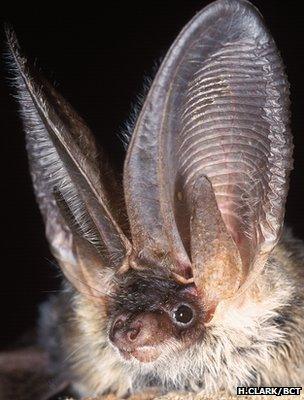Free online tool helps identify bat calls
- Published

Many bat species migrate, making a pan-European identification tool necessary
A freely available online tool that can identify the calls of bat species found in Europe could help improve knowledge of the mammals, a study has suggested.
Acoustic methods have been used more by researchers to monitor bat populations, but poor standardisation has limited efforts to collate EU-wide data.
Bats are considered vital indicators of ecosystem health, as they are sensitive to human impacts, the authors say.
The details of the paper appear in the Journal of Applied Ecology.
An international team of researchers say the need to survey and monitor bat populations has been recognised for some time, especially in regions where the animals are protected by wildlife laws, such as the EU Habitats Directive.
However, as most species are nocturnal, small and difficult to catch - it is not practical to rely on visual identification.
Instead, acoustic monitoring of bats' echolocation calls - sounds that the bats emit, allowing them to navigate, hunt prey and communicate with each other - is the preferred method.
"Lots of different measurements can be taken from an echolocation call, such as its minimum and maximum frequency, how quickly the frequency changes during the call," explains co-author Charlotte Walters from the Zoological Society of London.
"But we did not know which of these measurements are most useful for telling different species' calls apart," she adds.
'EchoBank'
The team selected 1,350 calls from 34 different European bat species from EchoBank, a global echolocation library containing more than 200,000 bat call recordings.
This raw data has allowed them to develop the identification tool, iBatsID, external, which can identify 34 out of 45 species of bats found in Europe.
They say the resulting online tool can identify most species correctly more than 80% of the time.
However, they add that there are a number of species that have calls that are harder to identify so the researchers recommend limiting IDs to subgroup levels.
The team expects iBatsID to greatly aid bat conservation because it offers a pan-European standardisation of acoustic - something that has been lacking until now.
Kate Jones, chairwoman of the Bat Conservation Trust, says acoustic monitoring plays a "very useful" role in bat conservation.
"But without using the same identification methods everywhere, we cannot form reliable conclusions about how bat populations are doing and whether their distribution is changing," Professor Jones observes.
"Because many bats migrate between different European countries, we need to monitor bats at a European - as well as country - scale.
"In iBatsID, we now have a free, online tool that works anywhere in Europe."
Ms Walters adds that as well as providing ecosystem services, such as controlling insect pests, the mammals are also a good indicator of habitat changes.
"Bats are very sensitive to changes in their environment," she explains.
"If bat populations are declining, we know that something is going on in their environment.
"Monitoring bats can therefore give us a good idea of what is going on with biodiversity in general."
- Published13 July 2012
- Published1 October 2011